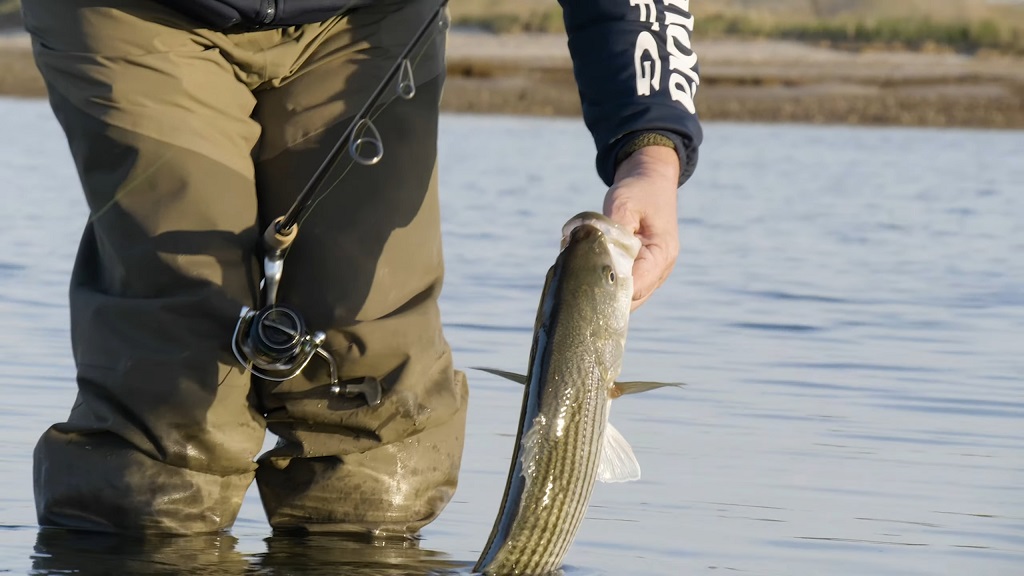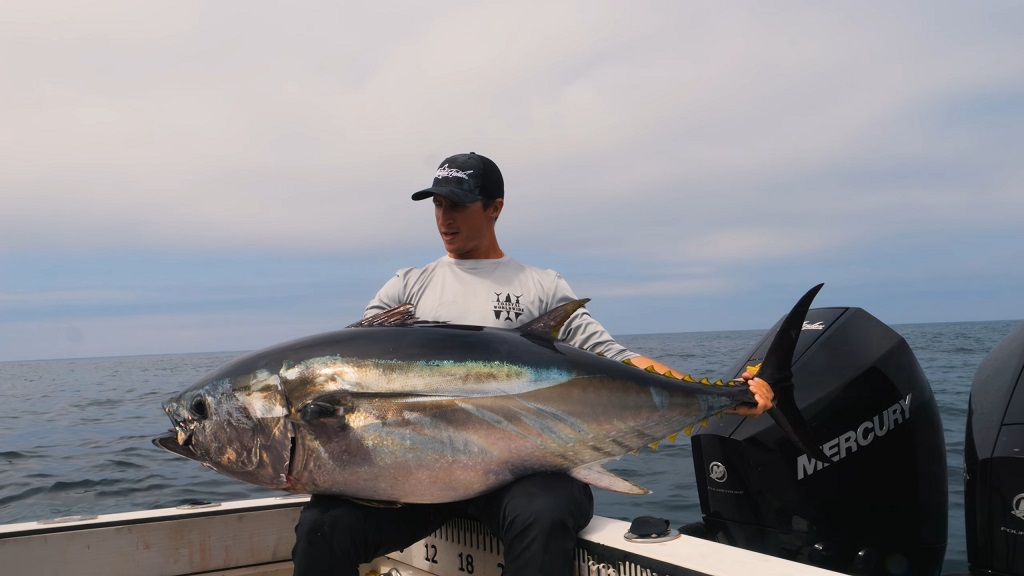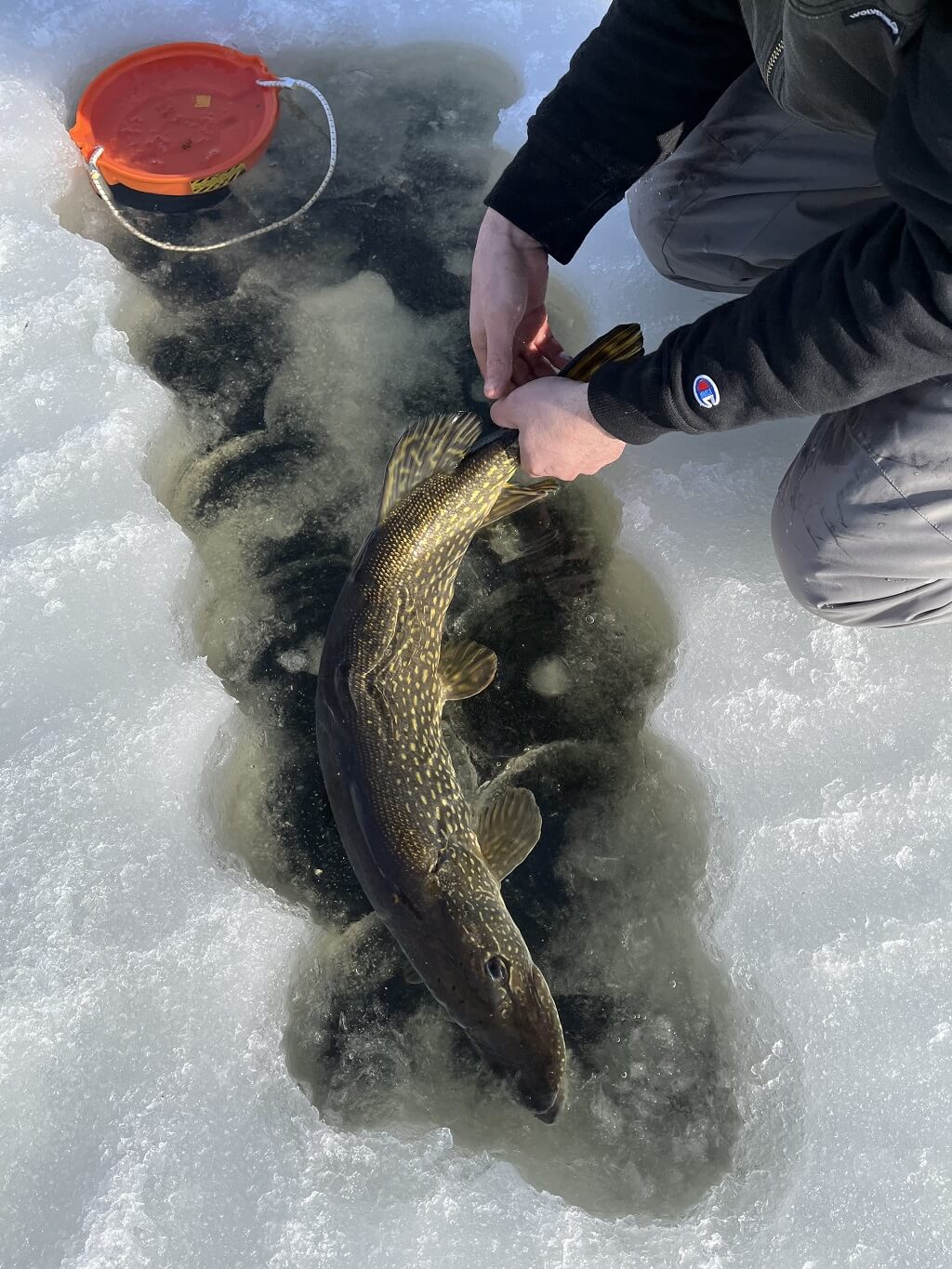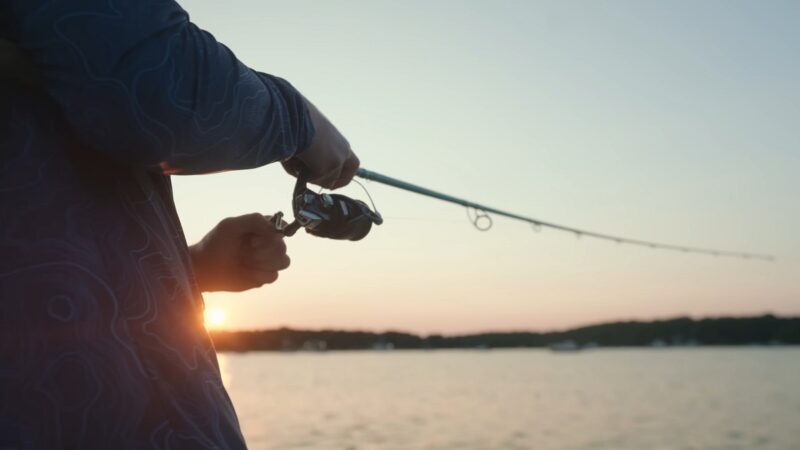Cape Cod Bay is one of New England’s most active fishing zones, shaped by clear environmental patterns. Covering about 600 square miles, it forms a natural bowl where tides, temperature, and migration align to create a predictable yearly rhythm.
In spring, warming waters bring mackerel and striped bass; in summer, bluefin tuna and cod move into deeper channels; by fall, tautog and bluefish dominate before winter resets the cycle.
Water temperatures swing from 42°F in April to nearly 70°F in August, and tides can rise or fall over 10 feet, stirring nutrients that feed every level of the food chain.
This seasonal rhythm supports one of the strongest fishing economies in Massachusetts, with striped bass charters, tuna runs, and groundfish fleets all thriving at different times of the year.
Spring Season (April–June)

Spring marks the start of the primary fishing cycle. As water temperatures rise above 45°F (7°C), plankton blooms attract baitfish like mackerel and menhaden, which in turn bring in striped bass, bluefish, and early-season tuna.
Striped bass typically migrate from Chesapeake Bay and the Hudson River, entering Cape Cod Bay in late April or early May. By June, they spread from Sandwich to Provincetown.
Spring fishing favors the southern and western edges of the bay, particularly off Barnstable Harbor and Scorton Ledge, where tidal rips push bait toward shallow bars. Anglers using umbrella rigs, bunker spoons, or live eels often report high catch rates.
Bottom fishing for flounder and haddock also begins around this time, with the Stellwagen Bank remaining a reliable hotspot for groundfish.
| Species | Peak Months | Common Depth | Preferred Bait | Water Temp Range |
| Striped Bass | May–June | 10–40 ft | Live eel, bunker | 50–65°F |
| Bluefish | Late May–June | 20–60 ft | Metal lures, mackerel | 55–68°F |
| Haddock | April–May | 120–180 ft | Clams, squid | 42–50°F |
Spring weather brings variability – calm mornings can turn into 25-knot wind afternoons without warning. The bay’s curved geography amplifies chop from northwest winds, making tide and wind alignment critical for safety.
Summer Season (July–September)

Summer transforms Cape Cod Bay into a diverse, high-activity zone. Warm water layers draw in larger pelagic species like bluefin tuna, while bottom waters remain cool enough to sustain cod and pollock. Striped bass move into deeper channels or around the outer shoals near Race Point, preferring cooler currents.
The Cape Cod Canal experiences its most intense striper runs around late June and early July, coinciding with the full moon tides.
Recreational boaters target sand eels and squid schools with light tackle or trolling setups. Offshore anglers begin chasing tuna between Stellwagen Bank and Peaked Hill Bar.
During this season, anglers must adjust their tackle for strength and precision. Heavy leaders, fluorocarbon rigs, and high-durability lines become essential when pursuing large tuna or sharks.
Midway through the summer, the presence of 500 lb fishing line setups is common among serious offshore crews targeting giants. These lines withstand both long runs and sharp directional changes, preventing snap-offs that can occur when a bluefin dives into the thermocline.
| Species | Peak Months | Best Zones | Avg. Weight | Notes |
| Bluefin Tuna | July–Sept | Stellwagen Bank | 200–800 lbs | Best early mornings |
| Striped Bass | July–Aug | Billingsgate Shoal | 15–40 lbs | Cooler tides preferred |
| Fluke | June–Aug | Barnstable, Brewster Flats | 2–6 lbs | Strong tides enhance bite |
| Dogfish & Sharks | July–Sept | Offshore drop-offs | 20–100 lbs | Common near chum slicks |
Summer conditions are marked by stable thermoclines and moderate southwesterly winds. Water clarity peaks in August, making sight casting and fly fishing along sandy flats productive, especially during calm dawn hours.
Fall Season (October–November)
Autumn is the bay’s transition period – a final feeding surge before winter migration. Water cools rapidly to 50°F, and baitfish begin leaving the estuaries.
This triggers aggressive feeding from remaining bass, bluefish, and late-season tuna. Offshore, the action concentrates along the northern rim of the bay near Provincetown and the Race.
Tuna remain in the area until the temperature drops below 52°F, often well into early November. Inshore, tautog and black sea bass dominate the bottom bite, thriving around rocky ledges and wrecks. Lobster traps fill the bay again as cold water improves crustacean movement.
| Species | Peak Months | Method | Depth | Notes |
| Tautog | Oct–Nov | Bottom rigs | 20–50 ft | Found near reefs and rock piles |
| Striped Bass | Sept–Oct | Live eels, plugs | 10–40 ft | Final migration push |
| Tuna | Sept–Nov | Trolling, chunking | 150–300 ft | Larger fish, fewer crowds |
Fall weather is volatile. Nor’easters can end the season abruptly, flattening water temperatures within a week. But in calm spells, fishing can be phenomenal – entire shoals of bass push baitfish onto the flats in front of Eastham and Brewster, creating brief but explosive blitzes visible from shore.
Winter Season (December–March)

Winter shuts down recreational fishing for most of the bay. Striped bass and bluefish migrate south, while tuna retreat into deeper offshore waters or the mid-Atlantic. Still, commercial fleets remain active.
Haddock, pollock, and cod are targeted near the deeper edges of Stellwagen and Jeffrey’s Ledge, though strict quotas limit effort. Ice occasionally forms along the inner harbors of Sandwich and Barnstable, signaling the true off-season.
Local anglers shift to maintenance, rig preparation, and electronics calibration. Weather windows are short and unpredictable; safety dominates every decision.
The commercial groundfishery remains the backbone of winter activity, supplying regional processors with cold-water species.
| Commercial Target | Avg. Depth | Gear Type | Regulatory Season |
| Haddock | 150–250 ft | Longline, trawl | Jan–Mar (limited) |
| Pollock | 200–300 ft | Jigging | Jan–Feb |
| Lobster | Traps | Nearshore 40–80 ft | Year-round (restricted in winter storms) |
Environmental Conditions and Tidal Influence
Cape Cod Bay’s fishing quality relies heavily on tide alignment, wind direction, and water clarity. The bay operates almost as a self-contained basin, where warm Gulf Stream eddies mix with cooler northern inflows. This balance shapes bait movement and oxygen levels across the year.
- Tides: Range from 9–11 feet, strongest near Sandwich and Barnstable.
- Surface Temperatures: 38°F in winter to 68°F in late summer.
- Salinity: Roughly 32–34 PSU, slightly lower near river mouths.
- Wind: Southwest winds dominate summer, while northeast gales define fall.
Understanding these patterns separates occasional catches from consistent results. Tide charts, NOAA temperature readings, and lunar cycles all serve as reliable planning tools.
Year-Round Overview
| Season | Primary Species | Avg. Temp | Typical Techniques | Key Areas |
| Spring | Striped Bass, Haddock, Flounder | 45–55°F | Trolling, bottom rigs | Scorton Ledge, Barnstable |
| Summer | Tuna, Striped Bass, Fluke | 60–68°F | Trolling, jigging | Stellwagen Bank, Race Point |
| Fall | Tautog, Tuna, Bluefish | 50–60°F | Chunking, bottom fishing | Provincetown, Eastham |
| Winter | Haddock, Pollock, Cod | 38–45°F | Deepwater jigging | Offshore banks |
Final Observations
Fishing Cape Cod Bay is about precision, not luck. Seasons are sharp, fish behavior is reactive, and weather changes dictate tactics hour by hour. The bay rewards knowledge – those who track tide data, water temperature, and bait concentration consistently outfish casual visitors.
Each year, environmental fluctuations – such as earlier warming or delayed cooling – slightly alter the timeline. Yet the overall rhythm of Cape Cod Bay remains stable: migration in spring, abundance in summer, aggression in fall, silence in winter.
For both shore anglers and offshore captains, this cycle defines one of the most studied and fished marine ecosystems in the North Atlantic.

